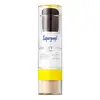What's inside
What's inside
 Key Ingredients
Key Ingredients

 Benefits
Benefits

 Concerns
Concerns

 Ingredients Side-by-side
Ingredients Side-by-side

Zea Mays Starch
AbsorbentMica
Cosmetic ColorantSilica
AbrasiveBambusa Arundinacea Stem Extract
Skin ConditioningZinc Stearate
Cosmetic ColorantPassiflora Edulis Fruit
Skin ConditioningRosmarinus Officinalis Leaf
Skin ConditioningRicinus Communis Seed Oil
MaskingCaprylic/Capric Triglyceride
MaskingTocopherol
AntioxidantAloe Barbadensis Leaf Powder
Skin ConditioningLeuconostoc/Radish Root Ferment Filtrate
AntimicrobialCalcium Aluminum Borosilicate
Zinc Oxide
Cosmetic ColorantSilica
AbrasiveCalcium Sodium Borosilicate
Polymethyl Methacrylate
Trimethylsiloxysilicate
EmollientBoron Nitride
AbsorbentLauroyl Lysine
Skin ConditioningPolyglyceryl-10 Pentaisostearate
EmollientTriethoxycaprylylsilane
Ethylhexylglycerin
Skin ConditioningWater
Skin ConditioningAscorbyl Palmitate
AntioxidantCeramide NP
Skin ConditioningNylon 6/12
AbsorbentOlive Glycerides
EmulsifyingTocopherol
AntioxidantSodium Dehydroacetate
PreservativeCI 77492
Cosmetic ColorantCI 77499
Cosmetic ColorantCI 77491
Cosmetic ColorantCalcium Aluminum Borosilicate, Zinc Oxide, Silica, Calcium Sodium Borosilicate, Polymethyl Methacrylate, Trimethylsiloxysilicate, Boron Nitride, Lauroyl Lysine, Polyglyceryl-10 Pentaisostearate, Triethoxycaprylylsilane, Ethylhexylglycerin, Water, Ascorbyl Palmitate, Ceramide NP, Nylon 6/12, Olive Glycerides, Tocopherol, Sodium Dehydroacetate, CI 77492, CI 77499, CI 77491
Ingredients Explained
These ingredients are found in both products.
Ingredients higher up in an ingredient list are typically present in a larger amount.
Silica, also known as silicon dioxide, is a naturally occurring mineral. It is used as a fine, spherical, and porous powder in cosmetics.
Though it has exfoliant properties, the function of silica varies depending on the product.
The unique structure of silica enhances the spreadability and adds smoothness, making it a great texture enhancer.
It is also used as an active carrier, emulsifier, and mattifier due to its ability to absorb excess oil.
In some products, tiny microneedles called spicules are made from silica or hydrolyzed sponge. When you rub them in, they lightly polish away dead skin layers and enhance the penetration of active ingredients.
Learn more about SilicaTocopherol (also known as Vitamin E) is a common antioxidant used to help protect the skin from free-radicals and strengthen the skin barrier. It's also fat soluble - this means our skin is great at absorbing it.
Vitamin E also helps keep your natural skin lipids healthy. Your lipid skin barrier naturally consists of lipids, ceramides, and fatty acids. Vitamin E offers extra protection for your skin’s lipid barrier, keeping your skin healthy and nourished.
Another benefit is a bit of UV protection. Vitamin E helps reduce the damage caused by UVB rays. (It should not replace your sunscreen). Combining it with Vitamin C can decrease sunburned cells and hyperpigmentation after UV exposure.
You might have noticed Vitamin E + C often paired together. This is because it is great at stabilizing Vitamin C. Using the two together helps increase the effectiveness of both ingredients.
There are often claims that Vitamin E can reduce/prevent scarring, but these claims haven't been confirmed by scientific research.
Learn more about Tocopherol